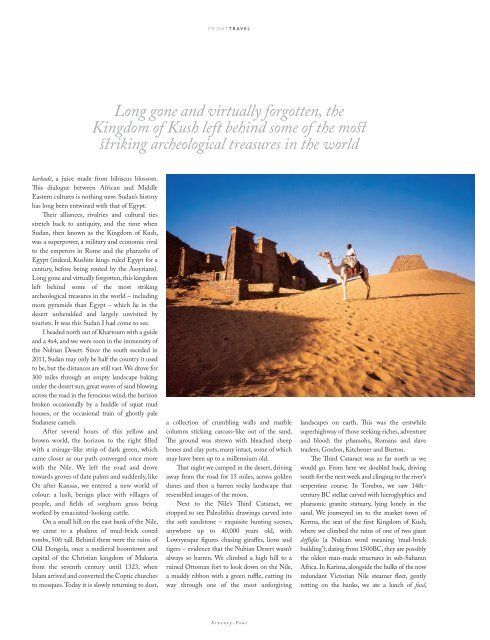Download - PrivatAir
Download - PrivatAir
Download - PrivatAir
Create successful ePaper yourself
Turn your PDF publications into a flip-book with our unique Google optimized e-Paper software.
PRIVATTRAVEL<br />
Long gone and virtually forgotten, the<br />
Kingdom of Kush left behind some of the most<br />
st riking archeological treasures in the world<br />
karkadé, a juice made from hibiscus blossom.<br />
Th is dialogue between African and Middle<br />
Eastern cultures is nothing new: Sudan’s history<br />
has long been entwined with that of Egypt.<br />
Th eir alliances, rivalries and cultural ties<br />
stretch back to antiquity, and the time when<br />
Sudan, then known as the Kingdom of Kush,<br />
was a superpower, a military and economic rival<br />
to the emperors in Rome and the pharaohs of<br />
Egypt (indeed, Kushite kings ruled Egypt for a<br />
century, before being routed by the Assyrians).<br />
Long gone and virtually forgotten, this kingdom<br />
left behind some of the most striking<br />
archeological treasures in the world – including<br />
more pyramids than Egypt – which lie in the<br />
desert unheralded and largely unvisited by<br />
tourists. It was this Sudan I had come to see.<br />
I headed north out of Khartoum with a guide<br />
and a 4x4, and we were soon in the immensity of<br />
the Nubian Desert. Since the south seceded in<br />
2011, Sudan may only be half the country it used<br />
to be, but the distances are still vast. We drove for<br />
300 miles through an empty landscape baking<br />
under the desert sun, great waves of sand blowing<br />
across the road in the ferocious wind, the horizon<br />
broken occasionally by a huddle of squat mud<br />
houses, or the occasional train of ghostly pale<br />
Sudanese camels.<br />
After several hours of this yellow and<br />
brown world, the horizon to the right fi lled<br />
with a mirage-like strip of dark green, which<br />
came closer as our path converged once more<br />
with the Nile. We left the road and drove<br />
towards groves of date palms and suddenly, like<br />
Oz after Kansas, we entered a new world of<br />
colour: a lush, benign place with villages of<br />
people, and fi elds of sorghum grass being<br />
worked by emaciated-looking cattle.<br />
On a small hill on the east bank of the Nile,<br />
we came to a phalanx of mud-brick coned<br />
tombs, 50ft tall. Behind them were the ruins of<br />
Old Dongola, once a medieval boomtown and<br />
capital of the Christian kingdom of Makuria<br />
from the seventh century until 1323, when<br />
Islam arrived and converted the Coptic churches<br />
to mosques. Today it is slowly returning to dust,<br />
a collection of crumbling walls and marble<br />
columns sticking carcass-like out of the sand.<br />
Th e ground was strewn with bleached sheep<br />
bones and clay pots, many intact, some of which<br />
may have been up to a millennium old.<br />
Th at night we camped in the desert, driving<br />
away from the road for 15 miles, across golden<br />
dunes and then a barren rocky landscape that<br />
resembled images of the moon.<br />
Next to the Nile’s Th ird Cataract, we<br />
stopped to see Paleolithic drawings carved into<br />
the soft sandstone – exquisite hunting scenes,<br />
anywhere up to 40,000 years old, with<br />
Lowryesque fi gures chasing giraff es, lions and<br />
tigers – evidence that the Nubian Desert wasn’t<br />
always so barren. We climbed a high hill to a<br />
ruined Ottoman fort to look down on the Nile,<br />
a muddy ribbon with a green ruffl e, cutting its<br />
way through one of the most unforgiving<br />
Seventy-Four<br />
landscapes on earth. Th is was the erstwhile<br />
superhighway of those seeking riches, adventure<br />
and blood: the pharaohs, Romans and slave<br />
traders; Gordon, Kitchener and Burton.<br />
Th e Th ird Cataract was as far north as we<br />
would go. From here we doubled back, driving<br />
south for the next week and clinging to the river’s<br />
serpentine course. In Tombos, we saw 14thcentury<br />
BC stellae carved with hieroglyphics and<br />
pharaonic granite statuary, lying lonely in the<br />
sand. We journeyed on to the market town of<br />
Kerma, the seat of the fi rst Kingdom of Kush,<br />
where we climbed the ruins of one of two giant<br />
deff ufas (a Nubian word meaning ‘mud-brick<br />
building’); dating from 1500BC, they are possibly<br />
the oldest man-made structures in sub-Saharan<br />
Africa. In Karima, alongside the hulks of the now<br />
redundant Victorian Nile steamer fl eet, gently<br />
rotting on the banks, we ate a lunch of fuul,


